Puffer fish have been an aquarium sensation with their appealing looks and intelligent nature for a long time. Not all, but some Puffers have beaks and bodies that inflate like water balloons, which they use for their defense.
Puffer fish carry tetrodotoxin poison. So, do not try to eat the Puffer fish. The Puffers may have an aggressive nature and ever-growing teeth like a beaver. So, do not house small, peaceful fish like Mollies with them.
They are very entertaining fish, always on the move in the aquarium. The Puffers have a strong memory, easily recognize their owners, and can be hand-fed.
The Puffers are very sensitive to water chemistry and the filtration system. They eat a lot and can create a lot of mess in the aquarium. So, keep changing water frequently.
In this article, we are going to explore the most popular Puffer fish and their diet, care treatment, tank requirements, and diseases.
Pea Puffer

This freshwater Puffer fish is considered the smallest Puffer in the world. It is known by many names like Pea Puffer, Dwarf Puffer and Pygmy Puffer. The minimum tank size must be 5 Gallon for the Pea Puffer.
You can easily house one male Pea Puffer with 2 to 3 females, but consider a bigger tank to facilitate the females hiding from males.
The Pea Puffers are shy and predator types of Puffers. So, keep in mind to provide them with small, dense places in the aquarium.
They thrive in hidden places. So, You can consider growing heavy plants and building small wood homes to imitate their natural habitat. Hardscaping materials such as Driftwood and Red Moor are also good to place in your aquarium.
You can feed them live or frozen foods, small insects, brine shrimps, and blood worms.
The Pea Puffers can be eaten by big fish and birds, too. Dense places and vegetation in the aquarium will help them feel secure in the shade, and they also become active in this way.
| Scientific Name | Carinotetraodon travancoricus |
| Size | 0.98 inches (25mm) |
| Food and Diet | Carnivores |
| Nature | Semi-Aggressive |
| Lifespan | 3-6 Years |
| Temperature Requirement | 75-82 Degree Fahrenheit |
| pH | 6.5-8.4 |
| Water Hardness | Moderate |
Corydoras imitator
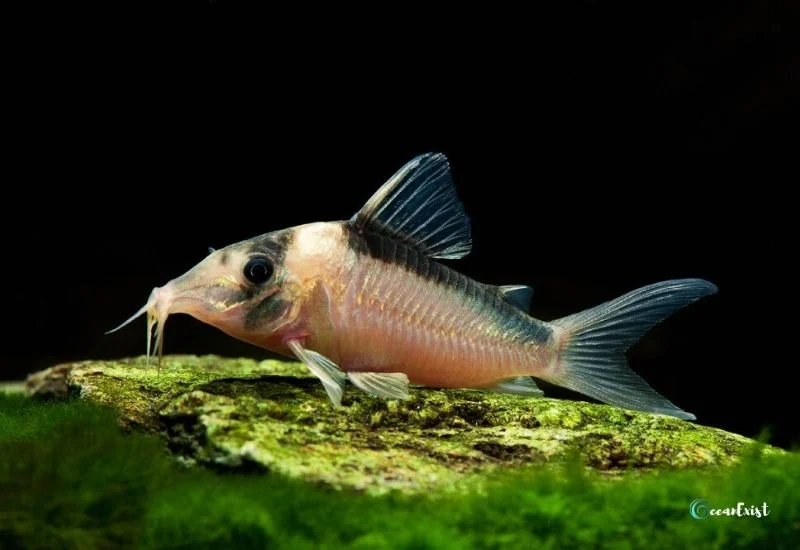
The Corydoras imitators are peaceful, friendly fish that live in the form of a community. They have black-silver colored body with a series of black bands covering their whole dorsal area. Their dorsal fins are little black and mostly apparent from the end.
Always house a group of Corydoras imitator fish, like 5-6 of them in the aquarium. Male Corydoras imitators grow up to 2.2 inches in size at their adulthood, while females grow larger and broader in size.
You should put a layer of fine gravel in the aquarium and clean the aquarium regularly to provide a better environment.
Do not house them with aggressive fish types such as Bettas in the aquarium. The ideal tank mates for the imitators are Tetras, small barbs, Pencilfish, and Dwarf Cichlids.
The Corydoras imitators are omnivores and can be fed small insects, crustaceans, and small worms.
For breeding, You can house two males with one female and provide them a visible area in the aquarium to catch the attention of their partner. Also, change 50%-70% daily and keep the aquarium temperature cooler until the eggs hatch.
| Scientific Name | Corydoras imitator |
| Size | 2.2-2.3 inches (55mm) |
| Food and Diet | Omnivores |
| Nature | Peaceful |
| Lifespan | 5 Years |
| Temperature Requirement | 77-81 Degree Fahrenheit |
| pH | 6.0-8.0 |
| Water Hardness | Moderate |
MBU Puffer
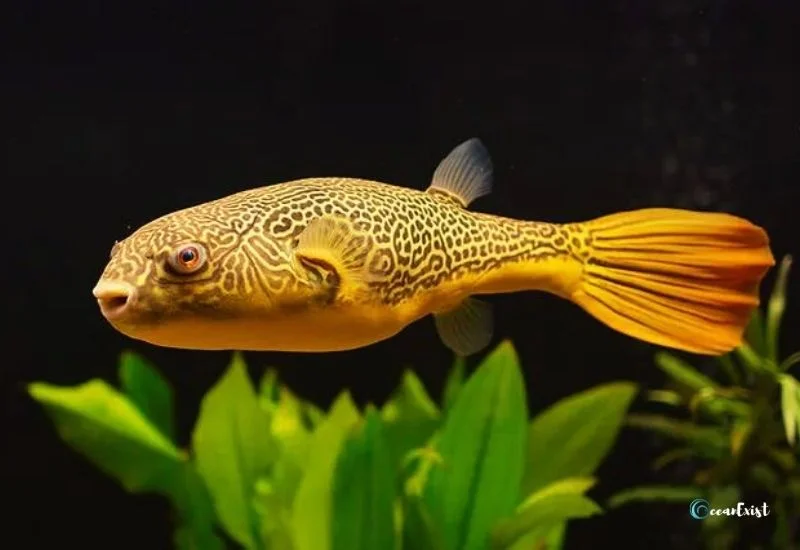
The MBU Puffer is considered as the largest Puffer and sometimes, it is named Mbuna puffer fish, giant Puffer fish, or Tetraodon MBU.
They have very bright yellow-colored bodies and keep a whimsical smile on their face, which seems like they are interacting with their visitors.
This species is known as the giant Puffer due to its very large size, which may grow up to 30 inches. That’s why it is difficult to house them in the aquarium.
Like other Puffers, the MBU Puffer is also capable of inflating the air and creating a body like an air balloon. They usually do this when they are stressed or frightened.
MBU is considered a beast in terms of their food and diet. They consume a lot of food including smaller fish, mollusks, crustaceans, snails, and worms. We also feed them live frozen food soaked in vitamin syrup twice a week.
MBU can easily be housed with other species who do not tend to engage in fights especially in their eating time. Horseface loaches, Geophagus cichlids, Tetras, and hillstream loaches are best mates for housing with MBU Puffers.
| Scientific Name | Tetraodon mbu |
| Size | 30 inches (76 cm) |
| Food and Diet | Carnivores |
| Nature | Semi-Aggressive |
| Lifespan | 3-6 Years |
| Temperature Requirement | 75-79 Degree Fahrenheit |
| pH | 7 |
| Water Hardness | Moderate |
Hairy Puffer
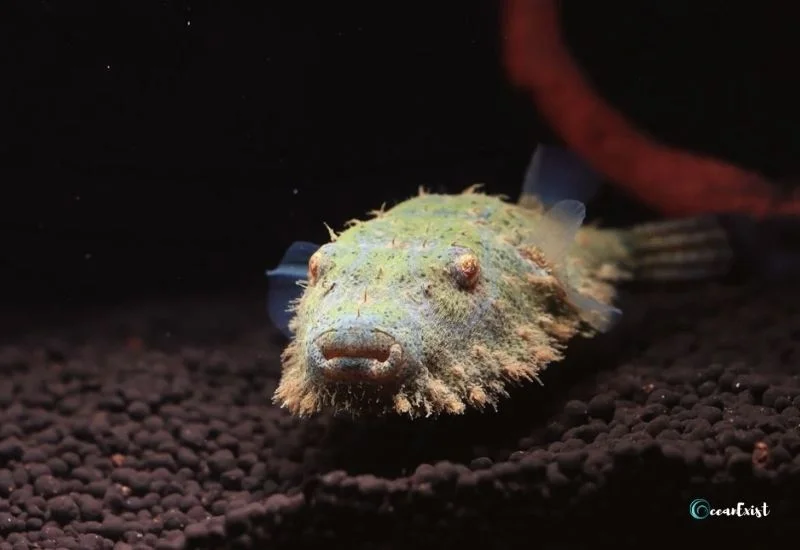
The Hairy Puffer is very similar to Arrowhead Puffer in appearance. But, It has a hairy beard on the lower jaw, which is why it is known as Hairy Puffer. It has a brown, black colored body. They are found in southeast Asian rivers where water currents are high and oxygenated flow is fast.
This fish is considered an extreme eater and creates a lot of waste in the aquarium. You will require a large-sized aquarium and a strong filtration system to house them.
Must install a powerhead in the aquarium to create a water flow angling up the water surface and splashing the surface. This will also help in creating a good oxygenated flow to match their natural habitat.
Place fine sand gravels in the substrate along with other soft stones and plants like java ferns and floating plants. If you want to house them with other species, create a lot of hiding spots and do some rockwork and install Driftwood.
Many aquarisits feed their Hair Puffer live and frozen food. But you can also feed them snails, small insects, and crustaceans.
| Scientific Name | Tetraodon baileyi |
| Size | 5 inches (13 cm) |
| Food and Diet | Carnivores |
| Nature | Vary in Temperament |
| Lifespan | 3-6 Years |
| Temperature Requirement | 75-80 Degree Fahrenheit |
| pH | 7 |
| Water Hardness | Moderate |
Green Spotted Puffer (GSP)
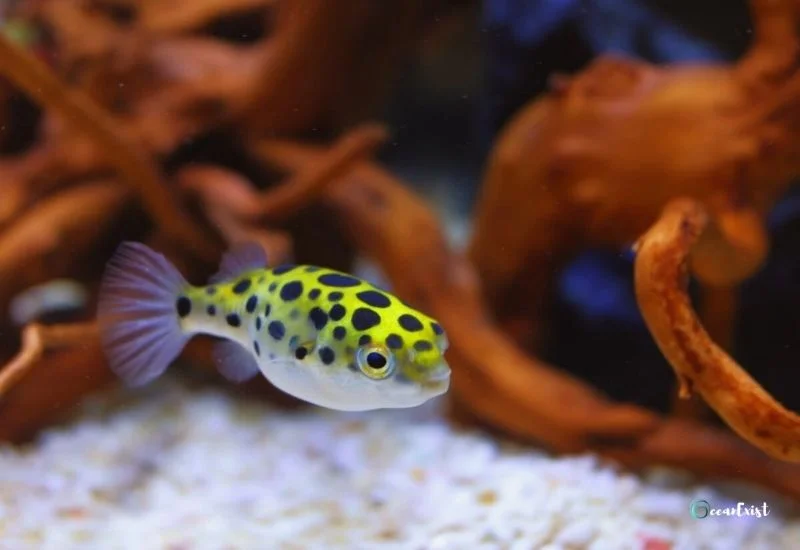
The Green Spotted Puffer is a very active and charming fish with a bright yellow-greenish colored body and black dots scattered all through its body.
They require special aquarium treatment and care for better health. They require a minimum of 30 gallons of tank size as they can grow up to 6 inches in size, and they constantly move in search of food.
We do not recommend housing them with any other fish species. Because they exhibit a very aggressive nature and may harm or kill other fish, but, some aquarists have experienced housing them with other Puffers. But, there always exists a risk of conflict between them.
If you want to house them with other mates, consider housing them with knight gobies, mollies, and scat-type species.
Consider changing freshwater by almost 30%-40% on a weekly basis. Do not add direct salt to their aquarium, as it may harm their body. First, mix the salt with clean water and pour it into the aquarium.
Their food is varied and they can be fed live or frozen food, brine shrimp, small carbs, etc.
| Scientific Name | Dichotomyctere nigroviridis |
| Size | 4-6 inches (10-15 cm) |
| Food and Diet | Carnivores |
| Nature | Semi-Aggressive |
| Lifespan | 10 Years |
| Temperature Requirement | 76-82 Degree Fahrenheit |
| pH | 7.5-8.5 |
| Tank Size | 30-40 Gallons |
Spotted Congo Puffer
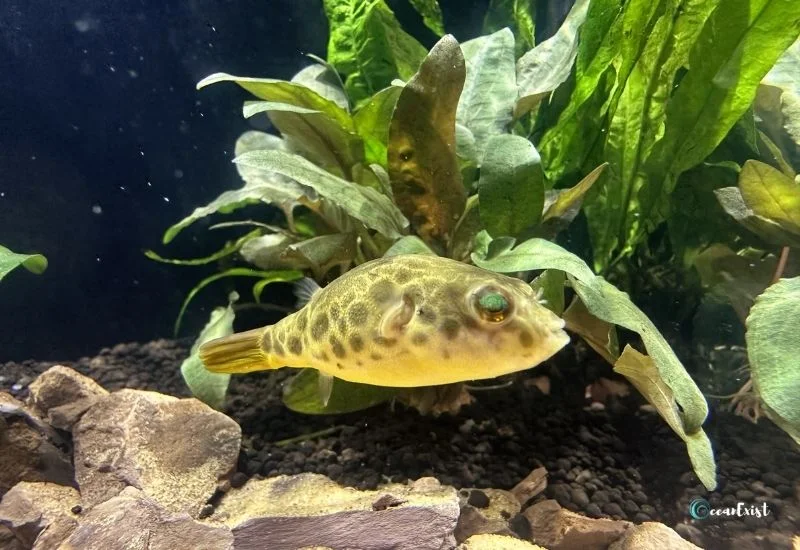
The Spotted Congo Puffer is also known as Pool Malebo, which is found in the low waters of the Congo River System in the Democratic Republic of Congo.
The Spotted Congo Puffers require a fairly large aquarium with a lot of rocks and crevices for their hiding. Place a soft sand layer of substrate in the aquarium as well.
These fish are voracious eaters and can create a lot of waste mess which will require a strong filtration and oxygenated system in the aquarium.
Just like the Green Spotted Puffer, the Spotted Congo Puffer will need a powerhead for creating water currents and improved oxygen flow to imitate their natural habitat.
These Puffers require a larger tank size with a lot of hiding places like live aquarium plants to break the line of sight. If there is a single male Spotted Congo Puffer, a tank size must be 30 gallons. But, if you have a group of other males and females, consider increasing tank size.
You can feed them small frozen foods, small insects, worms and brine shrimps.
Do not house them with species having a competitive nature who try to engage in fights over food. The best tank mates may be Corydoras, Congo tetras, peaceful plecos, and rainbowfish.
| Scientific Name | Tetraodon schoutedeni |
| Size | 3.9 inches (10 cm) |
| Food and Diet | Carnivores |
| Nature | Semi-Aggressive |
| Lifespan | 10 Years |
| Temperature Requirement | 74-80 Degree Fahrenheit |
| pH | 7 |
| Tank Size | 30 Gallons |
Amazon Puffer

The Amazon Puffers are very small, charming fish with bright yellow-white colored bodies and large circular eyes. This is a South American fish that can be found in the Amazon River basin.
This is a unique fish that survives in the community of other small-medium-sized peaceful fish. They are usually considered carnivores but can be fed live or frozen pieces of food. Their food consists of small insects, mollusks, worms, and other frozen fish foods.
The Amazon Puffers are very sensitive to deteriorating water quality. Like Spotted Congo Puffer, they will require water currents for surface splashing and good oxygenated flow in the water. Do not forget to change the freshwater on a weekly basis.
The Amazon Puffers are very intelligent and you may observe them playing some games in the water currents.
These Puffers may grow their sharp teeth if there is not a varied food diet for them. Consider feeding them crushed oyster shells with other frozen foods. This will allow them to scrape their teeth on the rocks and eat their food.
| Scientific Name | Colomesus asellus |
| Size | 4 inches (10 cm) |
| Food and Diet | Carnivores |
| Nature | Semi-Aggressive |
| Lifespan | 8-10 Years |
| Temperature Requirement | 72-82 Degree Fahrenheit |
| pH | 6.0-8.0 |
| Tank Size | 40-55 Gallons |
Red-Tailed Dwarf
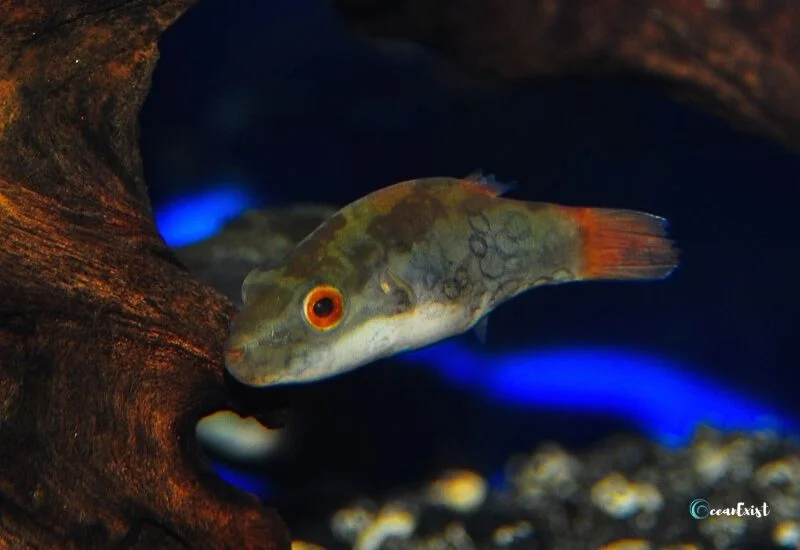
The Red-Tailed Dwarf is a small Puffer fish which has red eyes and a tail. This is also called Red-Eye Puffer, Red-Eye Red-Tail Puffer, and Red-Tailed dwarf puffer due to their physical appearance.
The Red-Tailed Dwarf is considered the most common Puffer, which is bred in a captive environment. They thrive best in heavily planted bushy areas, which help them provide hiding places in the aquarium.
The large aquatic fish like Java Ferns and Stem plants are best in providing a dense area for these fish to feel secure and remain active in the aquarium. These spaces in the aquarium also help the fish to breed.
It is also very important to provide these fish with a soft substrate where this fish can easily roll out.
Like other fish in the Puffer family, the red-tailed dwarf is also capable of growing a beak that needs to be worn down. You can do this by feeding them hard-shelled food like hard-shelled shrimps or hard-shelled oysters.
The male fish are usually territorial. So, it is recommended to house four females with one male in a group.
| Scientific Name | Carinotetraodon irrubesco |
| Size | 1.77 inches (4.5 cm) |
| Food and Diet | Carnivores |
| Nature | Semi-Aggressive / Territorial |
| Lifespan | 5 Years |
| Temperature Requirement | 71.6 -82.4 Degree Fahrenheit |
| pH | 6-7.5 |
| Water Hardness | 2-12 dGH |
Fahaka Puffer
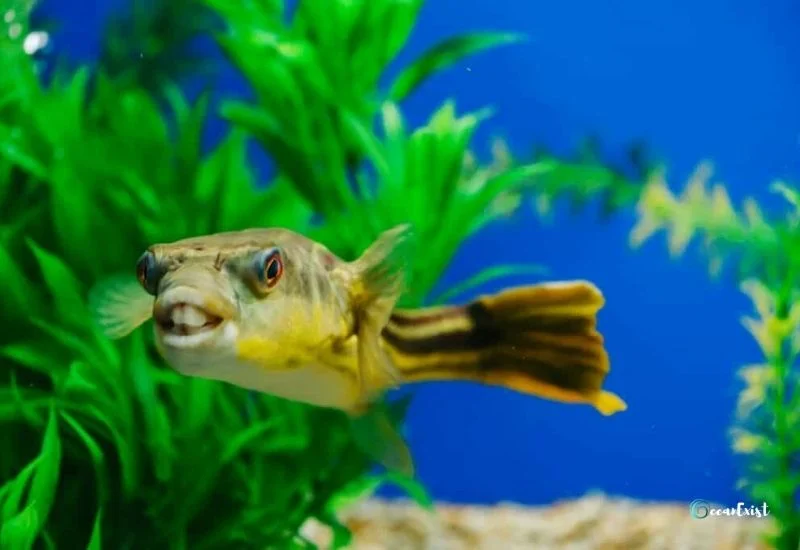
The Fahaka Puffer is also known as the Nile puffer, a globe fish found in the Nile, Chad, and Gabba.
The Fahaka Puffer is an aggressive fish which can grow very big in size. This fish requires an aquarium of larger size with a strong filtration and oxygenated system in the aquarium.
They cannot be kept with other fish due to risks of injuries. We have also experienced them causing injuries to fish keepers and local aquarists.
The Fahaka Puffer spends a lot of its time lying on the substrate in the aquarium. So, You can place a soft layer of sand or fine gravel on the substrate in the aquarium.
Like many other Puffers, the Fahaka Puffer has the ability to inflate the air in their body. They usually do this when they feel threatened or stressed.
| Scientific Name | Tetraodon lineatus |
| Size | 17.2 inches (45 cm) |
| Food and Diet | Carnivores |
| Nature | Aggressive & Territorial |
| Lifespan | 20+ Years |
| Temperature Requirement | 71.6-78.8 Degree Fahrenheit |
| pH | 6.5-7.5 |
| Water Hardness | 5-15 dGH |
Golden Puffer

The Golden Puffer is also known as Tetraodon lineatus, Tetraodon silus, Sphoeroides silus, and Tetraodon snyderi. They are usually found in large rivers in Thailand, Indonesia, and Malaysia.
They require an immediate level of care for a healthy living in the environment. If you are housing this fish, make sure to dim the aquarium lights.
These fish eat a lot of crunchy food and small fish. We have also observed them eating fins of live fish in the aquarium. They have ever-growing teeth which need to be worn down.
You should feed them hard-shelled food like hard-shelled oysters and other foods of similar type.
They are omnivores, and you can feed them a wide variety of meat and vegetables.
You should not place the Golden Puffer with other fish because of their aggressive nature. They can harm other fish and may eat them in the aquarium.
| Scientific Name | Auriglobus silus |
| Size | 4 inches (10 cm) |
| Food and Diet | Omnivores |
| Nature | Aggressive & Territorial |
| Lifespan | 10 Years |
| Temperature Requirement | 75-82 Degree Fahrenheit |
| pH | 7.0-7.6 |
| Water Hardness | 5-20 dKH |
Ocellated Puffer
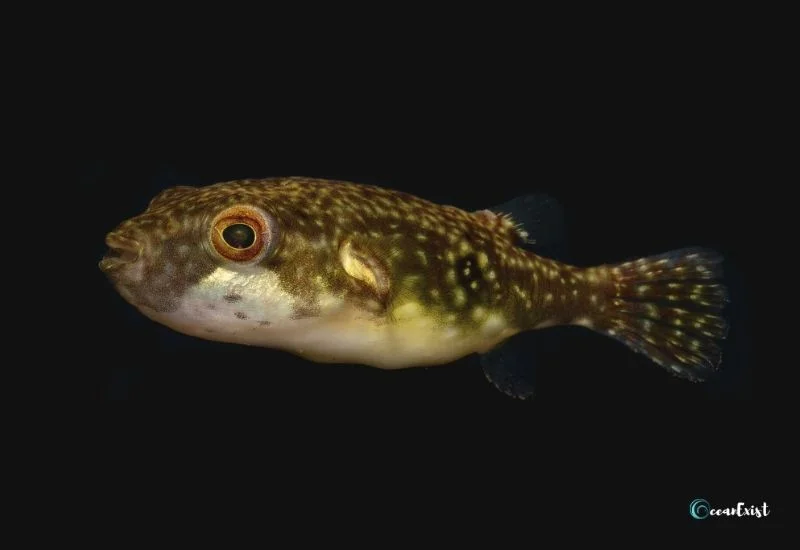
The Ocellated Puffer belongs to the Leiodon genus. This species is very interactive with its owners and is not easily found in local aquariums.
The Ocellated Puffers are found in ponds, rivers, streams and canals. They live in low-flow watered areas.
Their food consists of small insects and small meat parts of fish. The Ocellated Puffer Fish is considered the first fish to be bred in captivity. This fish is also regarded as low-care and easily bred in aquariums.
The Ocellated Puffer is a very aggressive fish. This fish is a solitary specimen, and it is not a wise decision to house them with other species.
They are habitual of high jumping. So, you have to arrange a tank with a large height.
You can feed them snails, small worms, insects and earthworms. This species requires safe, hidden places in their environment. You can provide shady space by growing stem plants like Limnophila sessiliflora, which will act as a natural habitat in the aquarium.
| Scientific Name | Leiodon cutcutia |
| Size | 5.9 inches (15 cm) |
| Food and Diet | Carnivores |
| Nature | Aggressive |
| Lifespan | 15 Years |
| Temperature Requirement | 75-82 Degree Fahrenheit |
| pH | 6.5-7.5 |
| Water Hardness | 4-15 dGH |
Arrowhead Puffer
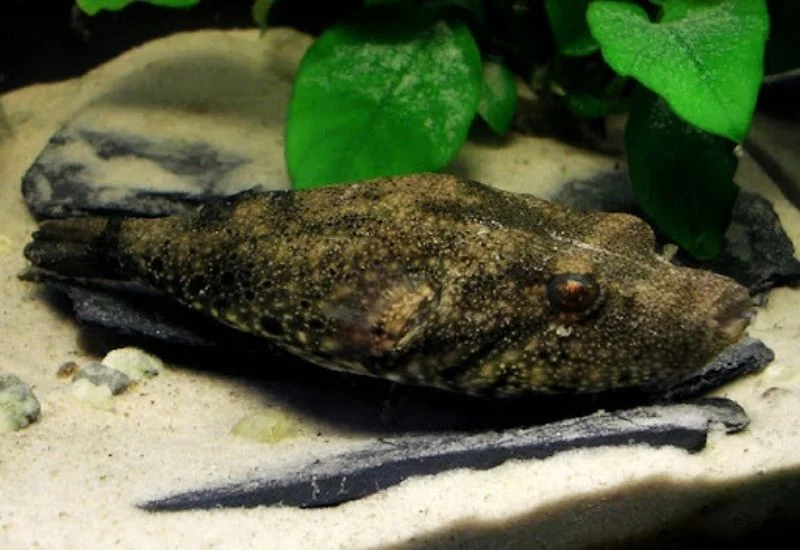
The Arrowhead Puffers are very aggressive and should not be kept in captivity with other fish. Like many other puffers, the Arrowhead puffers contain tetrodotoxin in their skin and teeth. So, You must avoid placing them with other small-sized fish in the same aquarium.
They are freshwater fish and do not require the addition of salt in the aquarium. They are very sensitive to deteriorating water. So, you must change the freshwater frequently.
Like other Puffers, the Arrowhead Puffers require hidden spaces in their captivity. You can place small rocks, driftwood and stem plants in the aquarium to imitate their natural habitat.
Like some other Puffers, the Arrowhead Puffers do not require food every day due to their inactive nature. You can feed them every other day, and adults can also be fed twice a week.
Their food consists of live foods like bloodworms, prawns, and brine shrimps. But, If they get trained to eat dead meat, it is a good alternative for them.
| Scientific Name | Tetraodon suvattii |
| Size | 6.0 inches (15 cm) |
| Food and Diet | Carnivores |
| Nature | Aggressive |
| Lifespan | 10 Years |
| Temperature Requirement | 72-79 Degree Fahrenheit |
| pH | 6.5-7.5 |
| Water Hardness | 5-12°H |
Congo Puffer
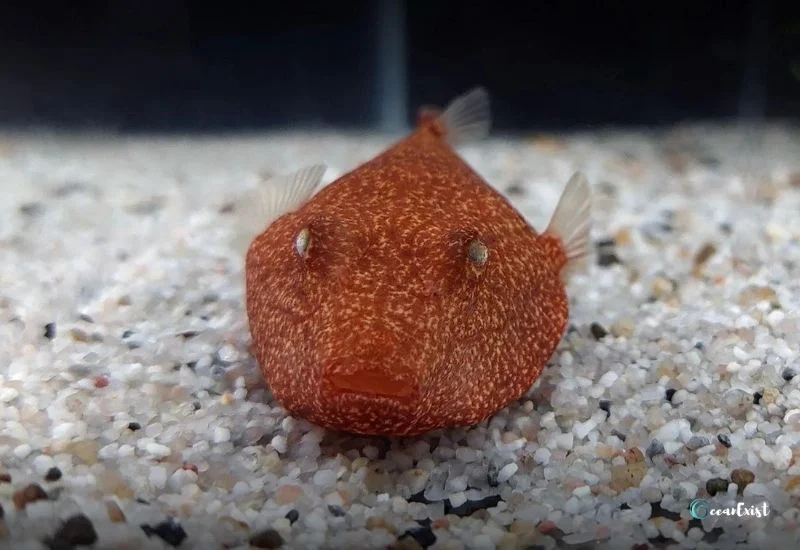
The Congo Puffers are freshwater Puffer fish like other Puffers. It is also known as Potato Puffer fish, and its red version is commonly named “Red Congo” or “Red Potato.”
The Congo Puffer mostly inhabits the clean, highly oxygenated, and high-flowing water in rocks and plants of the Congo basin.
Like many other Puffers, the Congo Puffers also require abundant space in their environment. You can place small rocks with escapes in between and plants to imitate their natural behavior.
There is no need to add salt to their aquarium because they are freshwater fish. But, small rocks and driftwood will allow them to roll in the water and will help to imitate their natural habitat.
A powerhead to create a strong water flow, and filtration will be the best choice for the Congo Puffers.
Their food consists of bloodworms, small insects, brine shrimps, and repashy.
| Scientific Name | Tetraodon miurus |
| Size | 6.0 inches (15 cm) |
| Food and Diet | Carnivores |
| Nature | Aggressive |
| Lifespan | 10 Years |
| Temperature Requirement | 77-80 Degree Fahrenheit |
| pH | 6.5-7.5 |
| Water Hardness | 4-15 dGH |
Red-Line Puffer
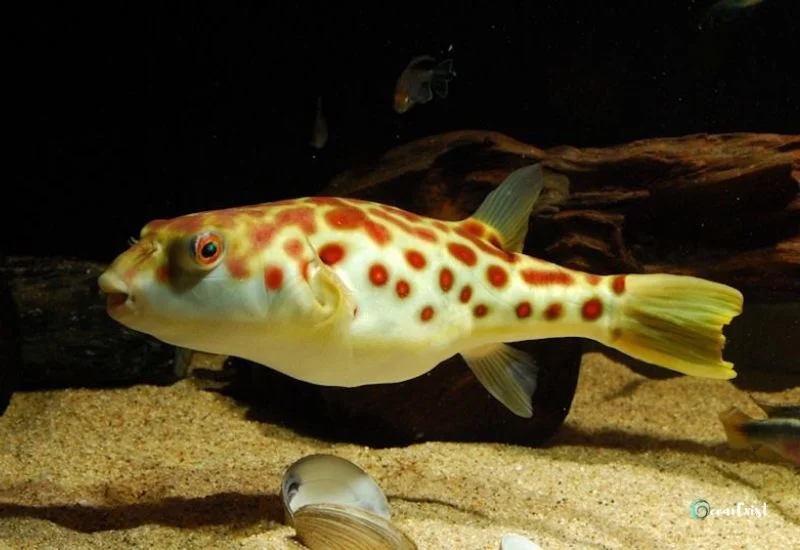
The Red-Line Puffer is a freshwater fish that belongs to a small town in Africa. They are considered endemic to Nigeria and Cameroon and are generally kept in virtual aquariums in these areas.
The Red-Line Puffer fish require a lot of hiding spaces in their aquatic environment. You can help them by placing small rocks, driftwood, and some shady plants to imitate their natural habitat.
These Puffers are considered plant-bitters, and they can easily destroy plants like Tiger Lotus, Crinum calamistratum, and also Aubias. So, you have to be very selective when decorating plants in the tank.
Like other Puffers, the Red Line Puffer also requires a lot of soft, sandy substrate.
The Red-Line Puffers can reach up to 40 cm in size. So, a bigger tank size of almost 570 liters gallons will be required to house them.
Their feed consists of small insects, bloodworms, brine shrimps, and other live or frozen fish food.
| Scientific Name | Tetraodon Pustulatus |
| Size | 14.0 inches (36 cm) |
| Food and Diet | Carnivores |
| Nature | Highly Aggressive |
| Lifespan | 20 Years |
| Temperature Requirement | 71.6 -78.8° Fahrenheit |
| pH | 6.5-7.5 |
| Water Hardness | 5-15 dGH |
Bullseye Puffer

The Bullseye Puffers are found on the Pacific coast of South and Central America. They are mostly housed in sandy places and rocky areas around the ocean.
They are highly aggressive fish and should not be placed with small, peaceful species such as Mollies. When they feel hungry, they can even bite and eat the fins of other fish. So, they should be placed with active and high-moving fish in their tank.
They have narrow black lines on their body, and have three yellow lines behind their eyes.
Their food usually consists of floating and sinking elements in the ocean. You can eat fish food like frozen meat, which sinks into the bottom of the aquarium.
The Bullseye Puffers are highly poisonous due to the availability of neurotoxins saxitoxin and tetrodotoxin in their skin and viscera. This helps them protect against the attacks of other larger fish.
| Scientific Name | Sphoeroides annulatus |
| Size | 7.0-18 inches (18-44 cm) |
| Food and Diet | Carnivores |
| Nature | Aggressive |
| Lifespan | 10 Years |
| Temperature Requirement | 74-80° Fahrenheit |
| pH | 7.0-8.2 |
| Water Hardness | 5-15 dGH |
Are freshwater Puffer fish hard to keep?
Freshwater puffer fish are not easy to care for and house in-home aquariums.
- First, You will need to change the tank water frequently.
- Second, They are large in size and require a bigger tank size exceeding the size of the average aquarium in the house.
- Third, Puffers are aggressive and cannot be housed with other mates in the aquarium.
Are freshwater Puffer fish poisonous to humans?
Most Puffers carry poison in their skin, teeth or viscera. They carry a poisonous material named Tetrodotoxin. Humans should not eat them at any cost. It is said that eating two full Puffer bodies can cause death in humans.
Can I touch a Puffer fish?
You should avoid touching Puffer fish. Almost all Puffers have spines and spikes all around their body. They carry a toxin called Tetrodotoxin, which can harm you, especially when the Puffers are puffed out.
How do you identify a Puffer fish?
These fish have spines and spikes all around their body. The Puffers have light gray, black, or golden color bodies. They are very aggressive and venomous species of freshwater fish.
Conclusion
In conclusion, there are many types of puffer fish in the world, and we have tried to explain the major types, their care requirements, diet requirements, and tank size requirements for housing them in captivity. If you have any queries, let me know in the comment section, and I will resolve them.
